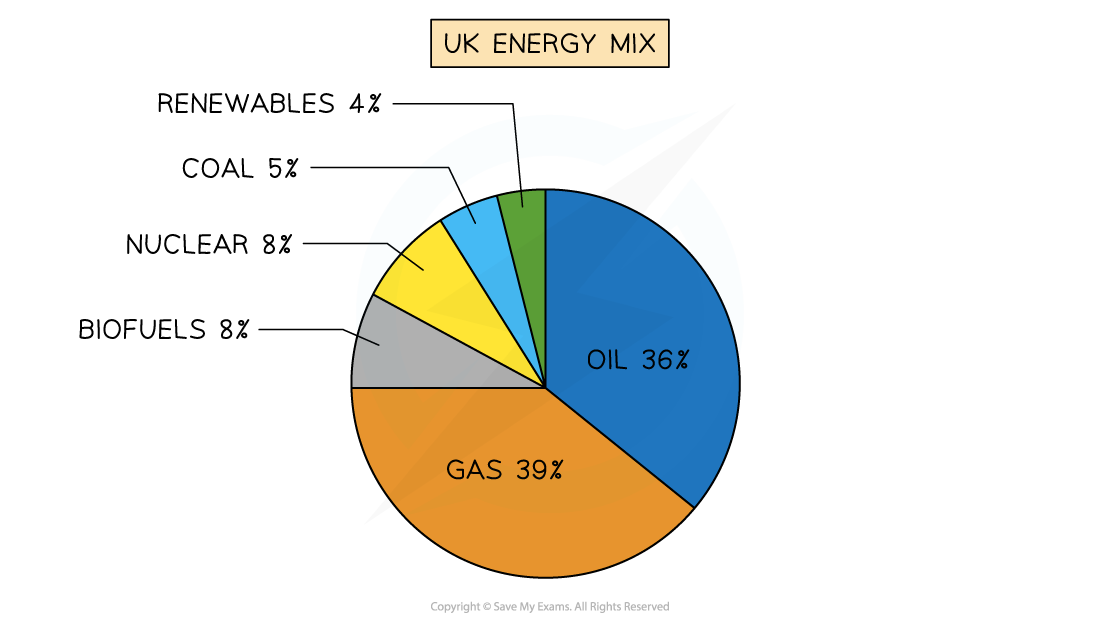Importance of Non-Renewable Fossil Fuels
- The demand for energy across the globe is rising
- Population growth and development are the two main causes of the increase in energy demand:
- The higher demand for food leads to more intensive farming which requires more energy for machines, light and heat
- Increasing industry requires energy for heating, lighting and machinery
- There is more transport all of which requires energy in the form of petrol, diesel or electricity
- Urbanisation increases with development increasing domestic appliances, heating, lighting
- Increased wealth means people buy more appliances and technology which require energy

World Energy Demand
- Over 80% of the world's energy is provided by fossil fuels (coal, oil and gas)
- 33% oil
- 27% coal
- 24% gas
- Fossil fuels are fuels formed from the remains of living organisms (plants/animals)
- These are non-renewable as they cannot be replaced at a speed which keeps up with consumption
- It is estimated that based on current use and availability, gas and oil will run out by 2080

World Energy Mix
- The use of nuclear and renewable energy is growing but non-renewables fossil fuels still dominate energy production
- It is predicted that the use of gas and oil will continue to increase over the next 30 years and these fossil fuels are expected to still provide over 75% of the world's energy by 2040
| Energy Source | Advantages | Disadvantages |
| Coal |
|
|
| Oil and gas |
|
|
Energy use
- MEDCs use more energy than LEDCs
- Countries with the highest energy consumption per person tend to be MEDCs and include Canada, Norway and Saudi Arabia
- Countries with the lowest energy consumption per person are LEDCs which are all in Africa and include Niger, Chad and Tanzania
- The greatest growth in energy use in LEDCs and newly emerging economies such as China and India
- Development means more use of energy in
- Businesses and factories
- In homes as people buy more appliances and technology
- Transport

Energy Use per Person in kwh
Energy security
- An energy gap is when a country cannot meet the demand for energy using its own resources
- When countries have an energy gap, they have to import energy to meet the demand
- Having an energy gap means that a country is not energy secure
- To be energy secure a country needs an:
- Uninterrupted supply of energy
- Affordable supply
- Accessible supply
- The UK has a widening energy gap and is not energy secure because:
- Renewable energy is not as efficient and so cannot replace full energy from fossil fuels
- It is cheaper to import fossil fuels than it is to exploit the resources in the UK
- The commitment of many countries to tackling climate change and reducing the use of fossil fuels has increased energy insecurity in many countries
- Energy security can also be affected by:
- Energy sources running out
- War/conflict
- Natural hazards
- Political disputes
Energy mix
- The energy mix in countries varies dependent on the level of development
- The most economically developed have a wider use of renewables and nuclear energy

- The newly emerging countries are more dependent on fossil fuels

- The least economically developed countries are dominated by biofuels which is mostly fuel wood used for heating and cooking particularly in rural areas

Worked example
Table 1 shows energy consumption in the USA in 2007 and 2016
Table 1

Describe the changes in non- renewable energy consumption shown in Table 1.
[3]
- Answer:
- Coal has decreased from 22.9% to 14.6% [1]
- Gas has increased from 23.3% to 29.2% [1]
- Oil has decreased slightly from 37.5% to 36.9% [1]
- Uranium has decreased slightly by 0.1% [1]

